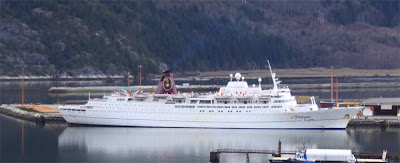Mona Lisa at her Squamish, British Columbia dock.
Photo ©2010 Aaron Saunders
October 1, 2010 is a very important date for older cruise vessels and their many followers, but not for a positive reason. This is the date that new requirements, called SOLAS 2010, come into effect - and render many classic vessels obsolete.
What is SOLAS 2010, exactly? Well, SOLAS stands for Safety of Life at Sea and 2010 merely refers to the year of effect. The governing body behind SOLAS actually dates back to 1914 and was formed in response to the Titanic disaster two years prior.
There have been successive versions of SOLAS intended to improve the saftey of passengers at sea, but these restrictions were normally only for newbuild ships and did not apply to existing vessels. SOLAS 2010, however, is designed to bring older vessels up to the same high standards as new cruise ships, through the use of fire-resistant materials and other enhancements like the elimination of maze-like stateroom corridors, better emergency lighting, fire suppression systems, and the location and placement of alarm and sprinkler systems in passenger areas.
Interestingly, these amendments have been a long time coming: the initial laws were drafted back in 1994, on October 1st, to be precise. All ships built prior to 1994 were given 16 years - or until October 1, 2010 - to comply.
Many newbuilds built in the early 1990s already complied and exceeded the new directives, but most classic passenger liners, and even some vessels built in the 1970's and 1980's, did not. Classic liners tend to have lots of real wood panelling in public areas, maze-like cabin corridors, and spotty fire suppression systems, if any.
In 2010, there are still a few of these vessels left - some are being refitted at tremendous expense to the cruise line, while others have sailed on with the full knowledge that, before the year is out, they will be withdrawn from service and find themselves headed for Alang, India - a place where ships are driven at full speed onto shore, and then cut apart piece by piece.
What ships are affected? The Mona Lisa, for one. Built in 1966 by John Brown & Company in Clydebank, Scotland as the MS Kungsholm, her most recent assignment has been as a floating hotel for the Vancouver 2010 Winter Olympics. Still tied up in Squamish, British Columbia, she faces an uncertain future at the end of the month. Potential plans are in the works for her to function as a floating hotel in Gothenburg, Sweden - but these have yet to be confirmed.
One ship with a less rosy outlook is the SS United States. Once the pride of the United States Lines fleet and current holder of the Blue Riband for fastest transatlantic crossing in 3 days, 12 hours and 12 minutes, the ship has spent the better part of her life languishing at a dock in Philadelphia. Stripped of her interiors and once top-secret engines, she experienced a brief ray of hope in 2003 when NCL purchased the ship outright, hinting at plans to refurbish and return her to service for their NCLA Hawaii brand.
Those plans never came to fruition, however, and earlier this year it was reported that NCL was entertaining bids from scrap merchants for the vessel, citing $800,000 per year upkeep costs. The SS United States Conservancy has indicated they would like to purchase the vessel, but are financially unable to do so. They were reportedly in talks with NCL, who did give them right of first refusal, but have yet to come to an agreement.
Many people would be thrilled to see the United States sail again. However, with the state of the economy and the costs of transforming a half-century old vessel into a modern cruise liner, the chances of that happening look slim indeed. Expect many watery eyes when the old girl is towed out into the Atlantic, and heads for India.
But the most frightening prospect for maritime buffs may be yet to come.
Since being sold to Dubai interests in 2008, the Queen Elizabeth 2 has sat idle at her berth after plans to convert her into a floating hotel and convention centre stalled. She then moved under her own power to drydock, with the hopes of sailing to Cape Town, South Africa to be used as a floating hotel for the 2010 World Cup Soccer season. Despite undergoing an exterior repainting to freshen her up for this appearance, those plans have fallen through as well. The QE2 has returned to her dock and tied up.
Rumors around the ship are swirling, with many expecting her current owners, Nakheel Properties, to want to offload the ship and her associated costs.
The danger here is that QE2's plans to live on as a floating hotel may fall through. While she comes closer to complying with the SOLAS 2010 regulations, without another substantial and costly refit, she will be inelegible to sail after October 1, 2010 - making a visit to Alang all the more likely - a move that would be devastating to maritime enthusiasts and historians everywhere.
We will of course keep you updated on the fates of all three of these unique and still glamorous vessels.


0 comments:
Post a Comment